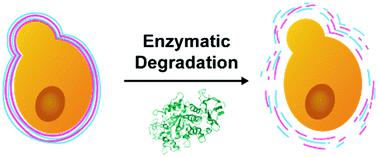当前位置:
X-MOL 学术
›
Soft Matter
›
论文详情
Our official English website, www.x-mol.net, welcomes your
feedback! (Note: you will need to create a separate account there.)
Enzymatically degradable, starch-based layer-by-layer films: application to cytocompatible single-cell nanoencapsulation.
Soft Matter ( IF 2.9 ) Pub Date : 2020-06-08 , DOI: 10.1039/d0sm00876a Hee Chul Moon 1 , Sol Han 1 , João Borges 2 , Tamagno Pesqueira 2 , Hyunwoo Choi 1 , Sang Yeong Han 1 , Hyeoncheol Cho 1 , Ji Hun Park 3 , João F Mano 2 , Insung S Choi 1
Soft Matter ( IF 2.9 ) Pub Date : 2020-06-08 , DOI: 10.1039/d0sm00876a Hee Chul Moon 1 , Sol Han 1 , João Borges 2 , Tamagno Pesqueira 2 , Hyunwoo Choi 1 , Sang Yeong Han 1 , Hyeoncheol Cho 1 , Ji Hun Park 3 , João F Mano 2 , Insung S Choi 1
Affiliation

|
The build-up and degradation of cytocompatible nanofilms in a controlled fashion have great potential in biomedical and nanomedicinal fields, including single-cell nanoencapsulation (SCNE). Herein, we report the fabrication of biodegradable films of cationic starch (c-ST) and anionic alginate (ALG) by electrostatically driven layer-by-layer (LbL) assembly technology and its application to the SCNE. The [c-ST/ALG] multilayer nanofilms, assembled either on individual Saccharomyces cerevisiae or on the 2D flat gold surface, degrade on demand, in a cytocompatible fashion, via treatment with α-amylase. Their degradation profiles are investigated, while systematically changing the α-amylase concentration, by several surface characterization techniques, including quartz crystal microbalance with dissipation monitoring (QCM-D) and ellipsometry. DNA incorporation in the LbL nanofilms and its controlled release, upon exposure of the nanofilms to an aqueous α-amylase solution, are demonstrated. The highly cytocompatible nature of the film-forming and -degrading conditions is assessed in the c-ST/ALG-shell formation and degradation of S. cerevisiae. We envisage that the cytocompatible, enzymatic degradation of c-ST-based nanofilms paves the way for developing advanced biomedical devices with programmed dissolution in vivo.
中文翻译:

可酶降解的,基于淀粉的逐层薄膜:应用于细胞相容性单细胞纳米胶囊。
细胞相容性纳米膜的形成和降解以受控方式在生物医学和纳米医学领域具有巨大潜力,包括单细胞纳米囊封(SCNE)。在这里,我们报告通过静电驱动的逐层(LbL)组装技术制造阳离子淀粉(c-ST)和阴离子藻酸盐(ALG)的可生物降解膜及其在SCNE中的应用。[c-ST / ALG]多层纳米膜组装在单个酿酒酵母上或在2D平坦金表面上,可按需以细胞相容性方式通过α-淀粉酶治疗。在系统改变α-淀粉酶浓度的同时,通过几种表面表征技术,包括带有耗散监测(QCM-D)和椭圆偏振的石英晶体微量天平,研究了它们的降解曲线。当纳米膜暴露于α-淀粉酶水溶液时,证明了DNA掺入LbL纳米膜中及其控制释放。在酿酒酵母的c-ST / ALG-壳形成和降解中评估了成膜和降解条件的高度细胞相容性。我们设想基于c-ST的纳米膜的细胞相容性,酶促降解为开发具有程序化体内溶出度的先进生物医学设备铺平了道路。
更新日期:2020-07-08
中文翻译:

可酶降解的,基于淀粉的逐层薄膜:应用于细胞相容性单细胞纳米胶囊。
细胞相容性纳米膜的形成和降解以受控方式在生物医学和纳米医学领域具有巨大潜力,包括单细胞纳米囊封(SCNE)。在这里,我们报告通过静电驱动的逐层(LbL)组装技术制造阳离子淀粉(c-ST)和阴离子藻酸盐(ALG)的可生物降解膜及其在SCNE中的应用。[c-ST / ALG]多层纳米膜组装在单个酿酒酵母上或在2D平坦金表面上,可按需以细胞相容性方式通过α-淀粉酶治疗。在系统改变α-淀粉酶浓度的同时,通过几种表面表征技术,包括带有耗散监测(QCM-D)和椭圆偏振的石英晶体微量天平,研究了它们的降解曲线。当纳米膜暴露于α-淀粉酶水溶液时,证明了DNA掺入LbL纳米膜中及其控制释放。在酿酒酵母的c-ST / ALG-壳形成和降解中评估了成膜和降解条件的高度细胞相容性。我们设想基于c-ST的纳米膜的细胞相容性,酶促降解为开发具有程序化体内溶出度的先进生物医学设备铺平了道路。











































 京公网安备 11010802027423号
京公网安备 11010802027423号